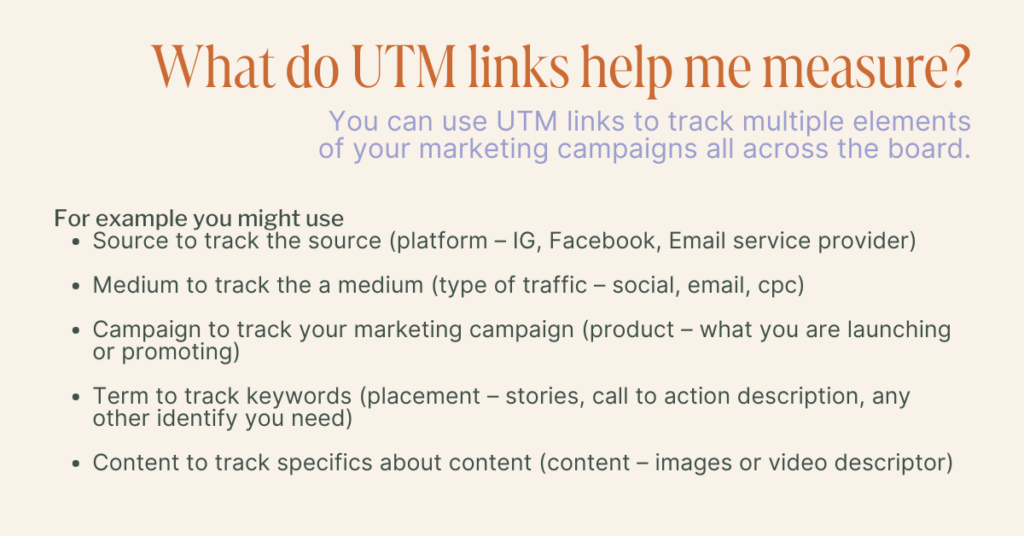Have you ever heard a business owner say that they know EXACTLY where their audience came from? Maybe they talk about how the majority of their newsletter subscribers came from their Instagram audience. Or how most of their blog traffic is driven directly from Google.
When you hear those things, you probably have a mix of thoughts – “Wow, that’s awesome!” but also, “How exactly do they know that??”
And that my friend is what I want to help you discover. There’s a way for you to know and understand data like this too. And it all starts with the UTM link.
If that sounds like a foreign language to you, don’t worry – I’m going to break it all down.
What is a UTM Link?
UTM links are special codes that help people who run websites keep track of where their visitors are coming from.
They began as a technology developed by a company called Urchin Software Corporation and were originally called Urchin Tracking Module. The UTM technology was acquired by Google and the term UTM is now widely used to refer to any system or method for tracking the source of website traffic.
UTM parameters are added to the end of a link so that the source of the website traffic can be tracked.
Do you sometimes notice when you click on a link there are a ton of question marks and strings of random words that don’t mean anything to you?

That’s a UTM link!
Those parameters mean something to whoever set them up!
Why Do I Need UTM Links?
UTM links allow you to track your website traffic sources most effectively!
UTM links can help you understand which pieces of your marketing campaigns are working – and once you know what’s working, you can do MORE of those things and leave behind the rest next time!
Essentially, UTM links allow you to make better decisions about where to spend your time, money, and energy when marketing your business.
Here’s what this might look like in action:
Picture this, you are headed for a new service launch!
You’ve planned out all your social and emails, and even booked in a few podcast interviews that are scheduled to go live during your launch – HELL YEAH!
And you used UTM parameters each time that you shared about your new offer!
The launch is over and you nailed it! 🥳
After you enjoy a relaxing weekend of couch naps and yummy food you are ready to dive in to dissect:
- How can you replicate this launch?
- What worked really well?
- What can you do less of next time?
- What produced results?
Because you used UTM links you are able to pinpoint which IG stories and emails drove purchases (or inquiries! I don’t know what service you just launched! 😜)
Sound like a situation you’d like to have?
Guess what? You can!
UTM parameters are extremely easy to use AND they’re free! Say less!
I’ll explain a little bit of theory about how to use them best next.
What do UTM links help me measure?
Short answer: tons of things! You can use UTM links to track multiple elements of your marketing campaigns all across the board.
For example, you might use
- Source to track the source (think platform – IG, Facebook, Email service provider)
- Medium to track the medium (think type of traffic – social, email, CPC)
- Campaign to track your marketing campaign (think product – what are you launching or promoting)
- Term to track keywords (I like to use this for placement. Think – stories, call to action description, any other identify you need)
- Content to track specifics about your content ( think – images or video descriptors)

There are so many use cases for UTM parameters.
The most important thing is that you decide on a naming convention that works for you and you use it consistently!
How Do I create UTM links?
- Head over to Google’s Campaign URL Builder.
- Grab the full URL of the webpage you want to send traffic to (Make sure you grab the HTTPS stuff.)
- Enter your parameters (Source, Medium, and Campaign are required)
- Copy the URL returned to you
Boom! You did it!
Remember when I mentioned UTM links were easy, and free?
Sweet! It’s also easy to get started!
You’ll need to
- Decide on a naming convention that works for you
- Build your UTM links
- Use them!
Overall, we all want to know that our marketing efforts are directly resulting in results for our business!
The most effective way to measure marketing effectiveness is to use UTM parameters – anytime you share a link, at least pop a source, medium, and campaign on the end of it!
Caveat: Do not use UTM links when linking internally. Why? Your previous parameters will be stripped and you’ll lose your tracking juice!
I could talk allllll day about the value of UTM links! Have a q? Find me here!
Looking for an easy way to craft and track the UTM links you are using! I gotcha covered!


leave a comment